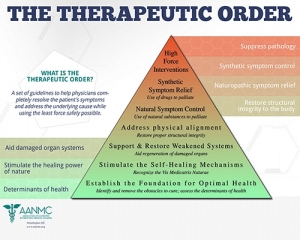A naturopathic guide to integrative treatment and policy: A new therapeutic order for 2017
January 3, 2017
by John Weeks, Publisher/Editor of The Integrator Blog News and Reports
A colleague, Pamela Snider, ND, recently sent a link to a new version of an organizing perspective, to which I have referred at least a score of times in my writing. Snider and her colleagues in naturopathic medicine have branded it as the “therapeutic order.” In the spirit of New Year’s resolutions, here for your consideration, or reconsideration, is a powerfully useful tool as we forge a way toward a new therapeutic order, both clinically and in the medical policy that guides the nation. The updated document, “A Hierarchy of Healing: The Therapeutic Order,” is publicly available as an early release of an ambitious, ten-year project to codify the practice of naturopathic medicine called The Foundations of Naturopathic Medicine. Snider serves as executive editor and hundreds of authors are involved. The chapter is presented as “The Unifying Theory of Naturopathic Medicine.” The authors’ preface to this need for ordering will be familiar to most involved in the integrative arena. One can be overwhelmed by the natural and traditional medicine products, practices, and practitioners in this superstore of natural remedies that might be useful to a patient in a specific moment. Approaches can be selected from around the globe. But which to choose and when? The authors, Jared Zeff, ND, Snider, and Australian author-researcher-educator Stephen Myers, ND, BMed, PhD (pictured left to right, below), note that ,“through the initial 50-year period of professional growth and development (1896-1945), naturopathic medicine had no clear and concise statement of identity.” A starting place for that early eclectic, integrative profession was the articulation, during the profession’s re-emergence in the 1980s, of a set of six principles. Among these:
The authors’ preface to this need for ordering will be familiar to most involved in the integrative arena. One can be overwhelmed by the natural and traditional medicine products, practices, and practitioners in this superstore of natural remedies that might be useful to a patient in a specific moment. Approaches can be selected from around the globe. But which to choose and when? The authors, Jared Zeff, ND, Snider, and Australian author-researcher-educator Stephen Myers, ND, BMed, PhD (pictured left to right, below), note that ,“through the initial 50-year period of professional growth and development (1896-1945), naturopathic medicine had no clear and concise statement of identity.” A starting place for that early eclectic, integrative profession was the articulation, during the profession’s re-emergence in the 1980s, of a set of six principles. Among these: - Doctor as teacher
- Finding and treating the cause
- Prevention
- The healing power of nature
 Yet, even this set of lights did not fully create clarity on the what-when questions. This required the concept of the “therapeutic order” that informs and guides the application of the principles. The authors of the paper explain their work as, “The therapeutic order is a natural hierarchy of therapeutic intervention, based on or dictated by observations of the nature of the healing process, from ancient times through the present. It is a natural ordering of the modalities of naturopathic medicine and their application.” The authors further clarify, “The concept is somewhat plastic in that one must evaluate the unique needs, and even the unique healing requirements, of the specific patient or situation, but in general the nature of healing dictates a general approach to treatment.” The job, for the clinician, is to find ways to respect and engage each of the lower tiers before moving toward “higher-force” and more suppressive, they say. Comment: One can insert in the place of “naturopathic medicine” the terms “integrative medicine” or “functional medicine.” The need for guidance in ordering the application of the cornucopia of possibilities is there across each. (An exploration of the modern naturopathic profession’s influence on the evolution of these two fields is here.) Most integrative health professions have a concept of using the least invasive first, when possible. Chiropractors refer to it as “conservative” care. In the naturopathic therapeutic order, the process, optimally, begins with addressing the determinants of health. It then moves through self-care and support of the terrain, then up through the application of approaches that typically are associated with least adverse effects to those with greater risks.
Yet, even this set of lights did not fully create clarity on the what-when questions. This required the concept of the “therapeutic order” that informs and guides the application of the principles. The authors of the paper explain their work as, “The therapeutic order is a natural hierarchy of therapeutic intervention, based on or dictated by observations of the nature of the healing process, from ancient times through the present. It is a natural ordering of the modalities of naturopathic medicine and their application.” The authors further clarify, “The concept is somewhat plastic in that one must evaluate the unique needs, and even the unique healing requirements, of the specific patient or situation, but in general the nature of healing dictates a general approach to treatment.” The job, for the clinician, is to find ways to respect and engage each of the lower tiers before moving toward “higher-force” and more suppressive, they say. Comment: One can insert in the place of “naturopathic medicine” the terms “integrative medicine” or “functional medicine.” The need for guidance in ordering the application of the cornucopia of possibilities is there across each. (An exploration of the modern naturopathic profession’s influence on the evolution of these two fields is here.) Most integrative health professions have a concept of using the least invasive first, when possible. Chiropractors refer to it as “conservative” care. In the naturopathic therapeutic order, the process, optimally, begins with addressing the determinants of health. It then moves through self-care and support of the terrain, then up through the application of approaches that typically are associated with least adverse effects to those with greater risks.  I start the new year with this posting for a couple of reasons. First, the importance of the importance of the social determinants of health has never been so pronounced in U.S. medicine. The National Academy of Medicine noted that the third most down-loaded of its publications in 2016, for instance, was A Framework for Educating Health Professionals to Address the Social Determinants of Health. The base of the naturopathic therapeutic order, as articulated by Zeff et al 25 years ago is finally getting some respect. Awareness is being elevated that clinical services are truly well up that pyramid. Only 10 percent to 20 percent of the factors shaping the health of a population are “healthcare” services. Most are clustered as “determinants.” Second, in the new Medicaid pain program in Oregon, and similarly in the U.S. Department of Defense and Veterans Administration, the opioid crisis is promoting policies that are in fact changing the therapeutic order of the state or nation toward use of less invasive, integrative strategies first. Instead of being in the historic when-all-else-fails position, “CAM” and non-pharmacological approaches are now appropriately being articulated and explored as first line options. The third and final reason for this posting is to point our efforts toward overcoming a huge obstacle in this welcome movement toward a more appropriate therapeutic order. We need a payment structure that supports this shift. Major medical organizations are for the first time calling for changes in payment. Without change, clinicians “are often backed into a corner when dealing with a patient’s pain.” Conventionally-trained physicians, even those interested in using integrative strategies, tend to “default to medications”. In the American Medical Association’s words, “public and private payer policies must be fundamentally altered.” Amidst the many challenges for health care that surfaced in 2016, these steps are good news in moving us in 2017, and forward, to shift the therapeutic order of the nation.
I start the new year with this posting for a couple of reasons. First, the importance of the importance of the social determinants of health has never been so pronounced in U.S. medicine. The National Academy of Medicine noted that the third most down-loaded of its publications in 2016, for instance, was A Framework for Educating Health Professionals to Address the Social Determinants of Health. The base of the naturopathic therapeutic order, as articulated by Zeff et al 25 years ago is finally getting some respect. Awareness is being elevated that clinical services are truly well up that pyramid. Only 10 percent to 20 percent of the factors shaping the health of a population are “healthcare” services. Most are clustered as “determinants.” Second, in the new Medicaid pain program in Oregon, and similarly in the U.S. Department of Defense and Veterans Administration, the opioid crisis is promoting policies that are in fact changing the therapeutic order of the state or nation toward use of less invasive, integrative strategies first. Instead of being in the historic when-all-else-fails position, “CAM” and non-pharmacological approaches are now appropriately being articulated and explored as first line options. The third and final reason for this posting is to point our efforts toward overcoming a huge obstacle in this welcome movement toward a more appropriate therapeutic order. We need a payment structure that supports this shift. Major medical organizations are for the first time calling for changes in payment. Without change, clinicians “are often backed into a corner when dealing with a patient’s pain.” Conventionally-trained physicians, even those interested in using integrative strategies, tend to “default to medications”. In the American Medical Association’s words, “public and private payer policies must be fundamentally altered.” Amidst the many challenges for health care that surfaced in 2016, these steps are good news in moving us in 2017, and forward, to shift the therapeutic order of the nation.



















SHARE